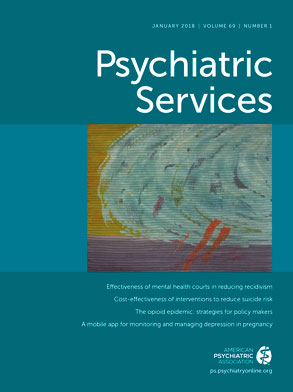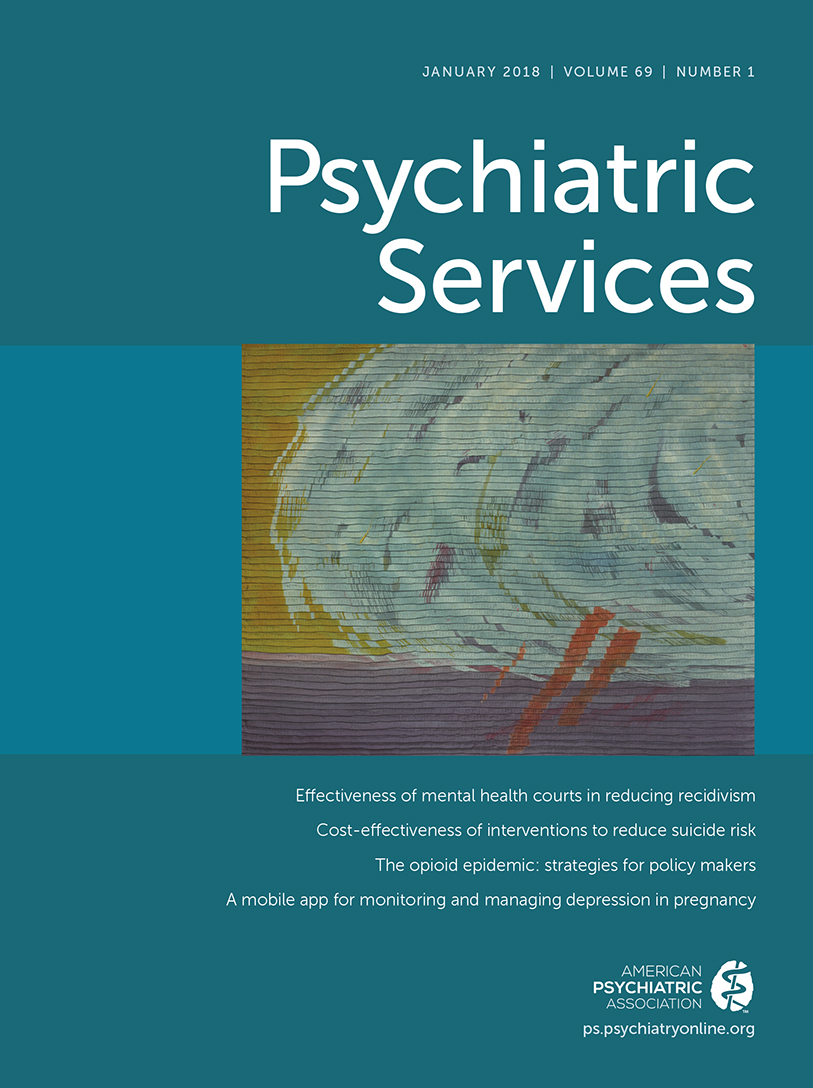Mental disorders among elderly persons are common and lead to significant disability and functional impairment (
1). However, less than 3% of older adults seek care with a psychiatrist, and most mental health treatment for older adults is provided in the primary care setting (
2). The collaborative mental health care model was developed to support and improve mental health treatment provided in primary care settings (
3). Collaborative care models typically include a mental health care manager, often physically present in the practice, who provides patient-centered education, counseling, and decision support to patients and their primary care providers (PCPs). A psychiatrist supervises the care manager and provides algorithm-driven tailoring of pharmacological and nonpharmacological treatment plans to PCPs as recommendations to implement (
3).
Numerous studies have demonstrated the benefits of collaborative mental health care interventions specifically targeting older adults (
4–
6). However, access and outcomes related to these programs may vary as a function of patients’ geographic location and income. Although such programs may improve care for patients without access to psychiatrists, their reach may be limited to urban or suburban practice settings large enough to support delivery. Collaborative care models with a care manager physically present may limit scalability and may not be practical for rural areas.
Many community-dwelling older adults with mental health conditions living in rural areas remain underidentified or lack access to specialty or home-based mental health care (
7), and access to collaborative care models in rural settings has been limited (
8–
10). Older adults with low incomes not only are more susceptible to mental health conditions (for example, depression and suicide completion) but also respond less favorably than their more affluent counterparts to psychotherapy and pharmacotherapy (
11). The development of mental health service delivery models that can more comprehensively identify and meet the needs of older adults with mental health conditions living in rural settings is needed (
12). The primary objective of this study was to evaluate the extent to which a community-based, telephone-delivered collaborative care intervention—the SUpporting Seniors Receiving Treatment And INtervention program (SUSTAIN)—that relies on pharmacy case finding is associated with similar access to integrated mental health care services among low-income older adults living in rural or in urban-suburban regions.
Methods
The sample included 8,621 older adults participating in SUSTAIN, a clinical service provided to older adults in Pennsylvania newly prescribed a psychotropic medication by a primary care or non–mental health provider, between August 2010 and May 2014. SUSTAIN participants are drawn from low-income older adults in the state of Pennsylvania who participate in the state’s Pharmaceutical Assistance Contract for the Elderly (PACE) or Pharmaceutical Assistance Contract for the Elderly Needs Enhancement Tier (PACENET), programs of the Pennsylvania Department of Aging that provide comprehensive prescription coverage for low-income, noninstitutionalized residents 65 years and older. The SUSTAIN program, provided through a clinical contract with the PACE program, provides a clinical assessment, mental health case management services, and consultation to patients’ providers. PACE/PACENET enrollees eligible for contact by the SUSTAIN program are older adults who fill at least one new prescription for an antidepressant, antipsychotic, or anxiolytic by a non–mental provider (with no prior pharmacy claim in that medication class in the prior 270 days).
PACE/PACENET enrollees are randomly sampled for the SUSTAIN clinical program every week from all claims submitted to PACE/PACENET for a newly written psychotropic prescription, stratified by medication type and county. The ratio of enrollees sampled for the SUSTAIN program in each medication class is not reflective of prescribing practices, but rather the sample is drawn to achieve a 4:2:1 ratio of antidepressants, anxiolytics, and antipsychotics. The PACE/PACENET program provides prescription coverage to more than 250,000 seniors across Pennsylvania. Estimates from PACE/PACENET indicate that from 2010 to 2014 approximately 50,000 enrollees met SUSTAIN program eligibility criteria and roughly 20% of these enrollees were sampled for the SUSTAIN clinical program.
Enrollees who agree to participate in SUSTAIN clinical services complete an initial clinical interview administered over the phone by a health technician. The health technicians are bachelor’s-level research technicians with extensive training in patient interviews and behavioral health assessments who receive ongoing supervision. The initial interview is not a research assessment but rather a clinical interview to assist the patient’s prescribing provider. This clinical assessment provides a software-aided mental health assessment and symptom monitoring. At completion of the initial assessment, a summary report is given to the provider regarding the patient’s symptoms to help with treatment planning (
12,
13).
This study aimed to evaluate whether participation in the SUSTAIN initial clinical interview differed by whether a patient lived in an urban or rural location. We examined sociodemographic characteristics (for example, age, gender, marital status, race-ethnicity, and financial status) and clinical characteristics (for example, depressive symptoms as measured by the nine-item Patient Health Questionnaire and anxiety symptoms as measured by the seven-item Generalized Anxiety Disorder scale, high-risk suicidal ideation, and at-risk drinking) among rural and urban-suburban older adults. Participants were categorized as rural or urban-suburban on the basis of their zip code of residence as indicated in PACE/PACENET patient records. We determined program penetration by dividing the number of older adults completing an initial SUSTAIN clinical interview by the number of older adults living in each zip code. The total number of older adults living in each zip code was extracted from a public state demographic database (
14).
Chi-square tests and analysis of variance were used to determine whether there were rural versus urban differences in completion rates for the initial clinical interview, patient sociodemographic and clinical characteristics, and program penetration. Multinomial regression analysis was performed to further assess whether there were rural versus urban differences in interview completion rates. The study did not evaluate or measure engagement in care management services. The study was approved by and conducted in accordance with the University of Pennsylvania Institutional Review Board.
Results
Of the 8,621 older adults whom PACE/PACENET identified as having been prescribed a new psychotropic medication between August 2010 and May 2014, a total of 2,151 (25.0%) completed the full initial clinical interview. Initial clinical interview completion rates by geographic location are shown in
Table 1. Of the 8,621 older adults, 12.1% were unable to complete the interview because of a communication barrier (non–English speaking or hearing or speech impairment) or cognitive impairment, and 32.4% were unable to be contacted for reasons such as a disconnected telephone line and inability to reach the patient after a maximum number of call attempts. In addition, 30.5% refused the assessment, citing reasons such as having stopped taking the medication prior to the call, privacy concerns, and lack of perceived benefit to participation
Most of the 2,151 older adults (mean±SD age=78.0±6.9) who completed the initial clinical interview were female (N=1,766, 82.1%), non-Hispanic white (N=1,970, 91.9%), and not married (N=1,586, 73.7%). Compared with urban-suburban participants, rural participants were more likely to be non-Hispanic white (N=739, 98.1%, versus N=1,231, 88.6%; χ2=60.4, df=1, p<.001), younger (77.3±6.7 versus 78.3±7.0; F=10.69, df=1 and 2,149, p<.001), and married (N=251, 33.2%, versus N=314, 22.5%; χ2=24.3, df=1, p<.001).
Examination of rates of completion of the initial clinical interview showed that older adults in rural counties were slightly more likely to complete the interview than those in urban-suburban counties (N=755, 27.0%, versus N=1,396, 24.0%; χ2=17.38, df=3, p=.001). No rural-urban differences were noted in type of index psychotropic medication. However, initial clinical interview completion rates differed by medication type; a smaller proportion of patients receiving antipsychotics completed the interview, compared with patients receiving the other medication types (χ2=567.5, df=6, p<.001). Multinomial logistic regression analysis found that urban participants were significantly more likely than rural participants to refuse the assessment (odds ratio [OR]=1.13, 95% confidence interval [CI]=1.01–1.28, p=.04) and to have been unable to be contacted (OR=1.27, CI=1.13–1.44, p<.001) than to have completed (reference group) the interview. These results remained unchanged when the analysis controlled for index medication type.
The program penetration rate was higher in rural counties compared with urban-suburban counties (.2%±.002% versus .1%±.001%; F=5.98, df=1 and 65, p=.02).
Discussion and Conclusions
This study found that the SUSTAIN clinical service was able to reach individuals regardless of their geographic location to participate in an initial clinical assessment. Given limited access to specialty mental health care and to mental health staff who can provide in-person care management services, which is particularly acute in rural settings, implementation of programs that can reach older adults, regardless of location, is critical. SUSTAIN program features— including identifying potential participants via pharmacy case finding and offering telephone-based delivery of all services—may help overcome barriers to engagement associated with patients’ geographic residence, including lack of time, local treatment resources, and transportation options (
15). Patients participating in the SUSTAIN program have demonstrated significant improvements in overall mental health functioning, as well as reductions in symptoms of depression and anxiety in previous trials (
12). Our findings suggest that this model facilitates access for patients regardless of geography.
However, a large number of patients were unable to be contacted or refused an assessment. Although use of pharmaceutical claims to identify patients may provide an important case-finding mechanism, this approach is limited by the quality of the contact information and the ability to contact these patients. In addition, although finding cases by using claims data may increase identification of potential participants, lack of provider referral to the program before the SUSTAIN program initiated contact may have led to a higher refusal rate. Understanding patients’ reasons for not completing the initial assessment is critical for SUSTAIN and for telephone-based delivery models more generally.
The study had several limitations. PACE/PACENET enrollees’ addresses are updated on an annual or semiannual basis. Thus an individual’s address may have changed from urban-suburban or rural status during the study period. Also, our estimates of program penetration may be conservative because the denominator was all older adults in a given zip code and not older adults who were potentially eligible for enrollment in the SUSTAIN program.
Because access to mental health care for older adults and those in rural areas is limited, telephone-based delivery models are critical to improving access to care for rural-dwelling older adults. Using mental health care management delivered by telephone, the SUSTAIN program extends care management in two ways. First, it extends the geographic reach of such programs, which typically involve an in-person care manager, by using a completely telephone-based intervention. In fact, our results suggest that rural-dwelling adults were more likely than those in urban-suburban areas to engage with the clinical service. Second, by implementing case finding from pharmacy claims, programs may reach more patients than if limited to clinician referral. The SUSTAIN clinical program offers a platform on which to build low-cost interventions to reach patients regardless of location. However, to realize the full potential of such delivery models and to maximize their potential to help those that may benefit most, we will need to better understand the factors that influence not only access but also engagement.

